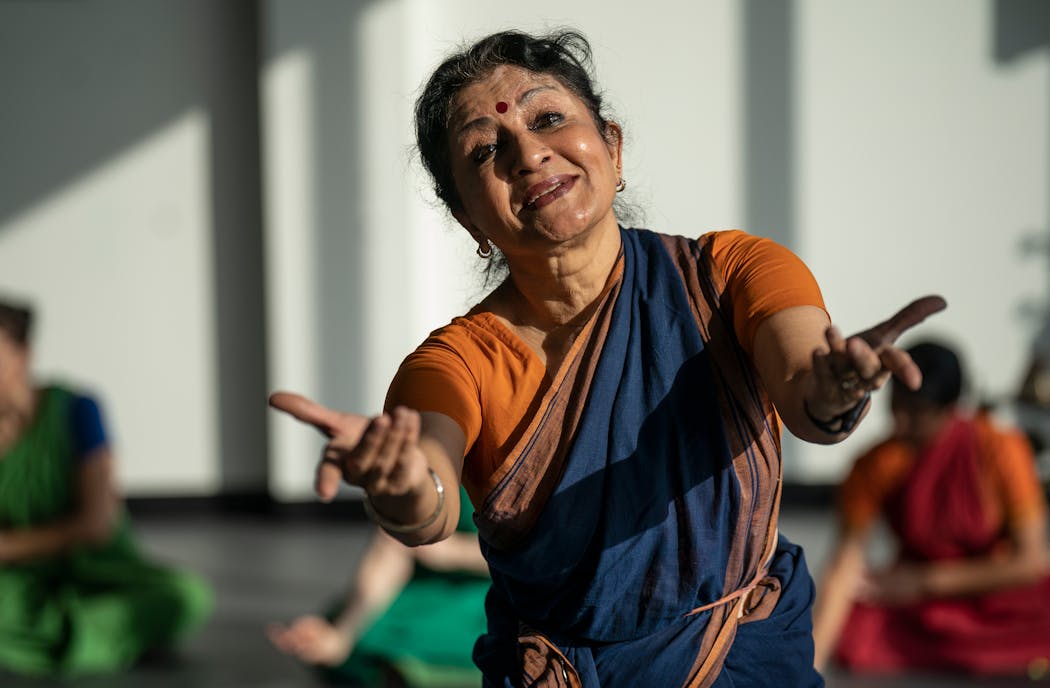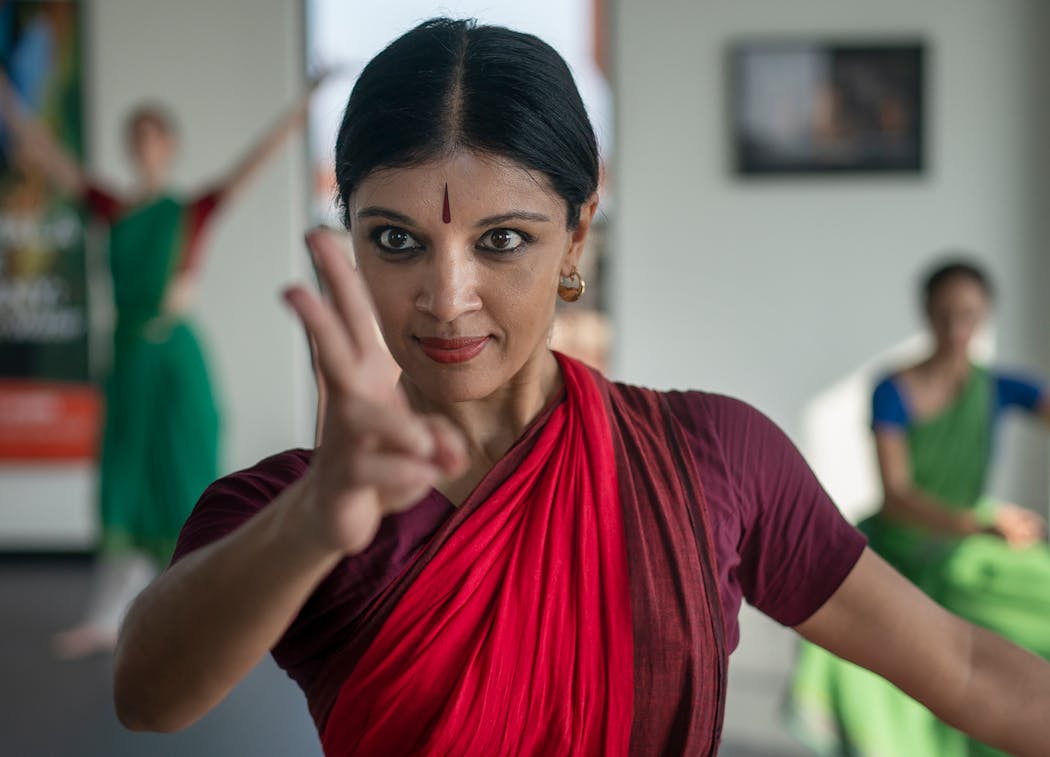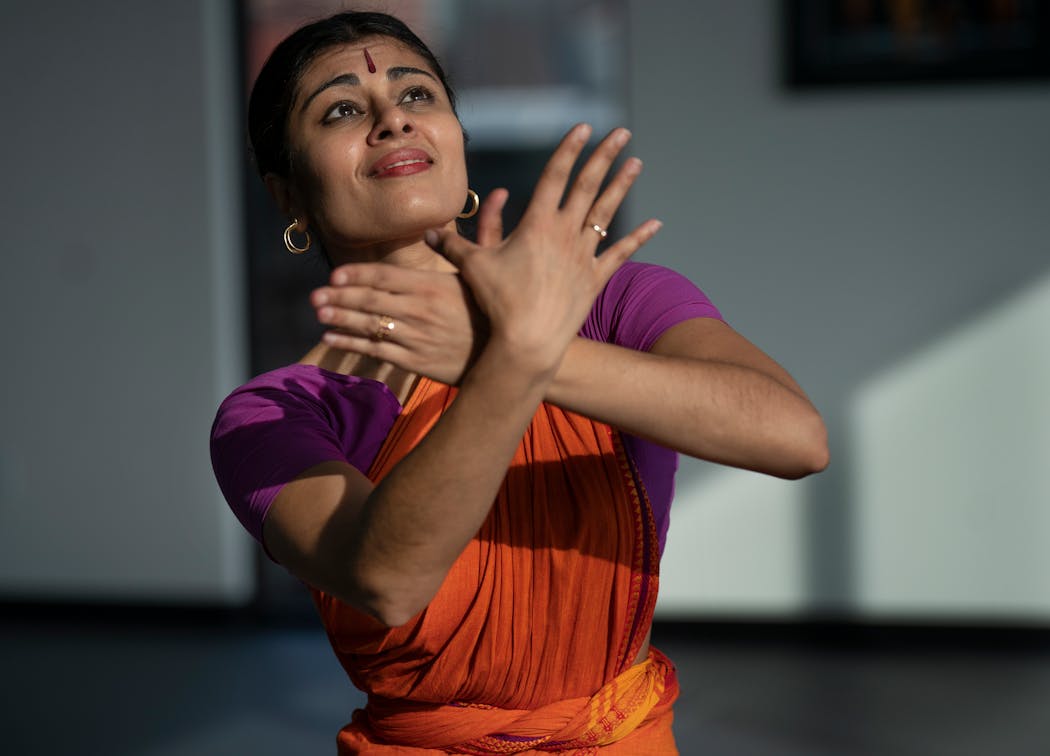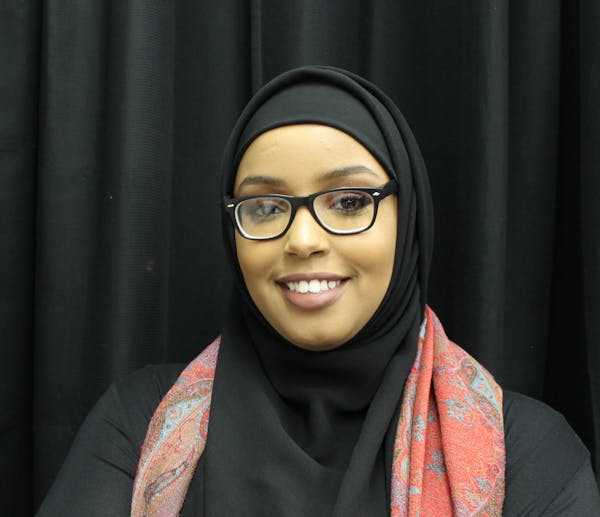At a recent rehearsal at Ragamala Dance Company's space at the Center for Performing Arts, co-artistic director Ranee Ramaswamy engaged every facet of her body — from each bone in her fingers and toes to her ribcage, neck and elbows. Her face conveyed emotions through expressions. She didn't just smile, she glowed.
She, along with her daughters Aparna and Ashwini and their troupe, were practicing mudras (intricate hand positions), abhinayas (expressional movements) and brisk footwork for Ragamala's latest work, "Fires of Varanasi: Dance of the Eternal Pilgrim," which will be performed Saturday at Northrop.
Her company specializes in the Pandanallur style of bharatanatyam, the South Indian dance form that was originally performed as solo acts at Hindu temples by female dancers conveying religious stories. Ragamala's performances incorporate an ensemble element, while keeping the notion of solo dancing at the forefront. Each dancer in the company is a soloist, even if they happen to be moving in synchronicity with other performers.
So, too, does the Ramaswamy family. Ranee, Aparna and Ashwini each pursue their artistry as individuals in their own right, but also bring the art form together in their stage performances.
Growing up in Chennai (then Madras), India, Ranee said as a child she begged her parents to let her learn bharatanatyam. But she gave it up, got engaged at 17 and married at 20. In 1978, after she had moved to the United States with her first husband and Aparna (Ashwini was born later in Minneapolis), she was asked to give a performance at the University of Minnesota's Coffman Memorial Union, and that reignited her love for the dance form.
When the renowned bharatanatyam dancer Alarmel Valli led a workshop at Coffman, she asked Aparna, who was then 8 and had no training yet, to return with her to India and be her student. Ranee said yes, only if she, too, could study under Valli. In 1992, founded Ragamala, and started teaching dance to about 30 students out of her home in Burnsville.
Over the decades, Ragamala became a performing company and now has around 70 students. Aparna, who is known for her solo acts, co-directs Ragamala along with her mother and they both teach special classes for senior students and company members by invitation only.
Ashwini also teaches classes with a roster of other teachers. She first learned bharatanatyam when she was 5, but gave it up. Then she recommitted to study the dance form as an adult and in recent years has ventured out on her own as an independent artist, choreographing pieces notably for the Liquid Music Series and the Great Northern festival.
In pre-COVID times, Ragamala used to travel widely. Tours especially kicked off after its 2011 premiere of "Sacred Earth," which officially opened the Cowles Center in Minneapolis. The company has received critical accolades, commissions and awards nationally and internationally and has performed at the Lincoln Center Out of Doors in New York, Jacob's Pillow in the Berkshires and in Abu Dhabi and Paris.
It has had three premieres outside Minnesota, the most recent being "Fires of Varanasi" at the Kennedy Center in Washington, D.C., which was part of the venue's 50th anniversary celebration last year. It was performed outdoors on a reimagined set of three platforms and underneath a moonlit sky.
The piece explores notions of death and rebirth and man's relationship with the Gods. It takes place metaphorically on the waters of the Varanasi River, a pilgrimage destination where Hindus cremate the dead. Between fire and water, the work is about journeys and crossings.
Ashwini said they are now excited to bring the performance home.
"We have been creating and performing work here in the Twin Cities for almost 30 years, and there is nothing like performing for our home audiences," she said.
The Ramaswamys spoke about their relationship, sometimes finishing each other's sentences, and what dance means to them. Here are edited excerpts from the conversation.
Q: How have your relationships grown — personally and artistically?
Ranee: We are a very close-knit family. Even though we are very different from each other, I think bharatanatyam connects us because we have one art form. We understand what it is, how great it is and how sacred it is.
Ashwini: During the pandemic, we were our own little bubble. Every day it was us in our studio.
Aparna: We spent our time practicing together, creating together. It felt so nourishing to our souls.
Ashwini to Ranee: You really did so much self-reflection in your practice. That was seeped into us as well and it fed into our relationship.
Ranee: During this break, I decided that since I'm turning 70 in March, I wanted to make a change in my performance. I completely switched to the expressive element of my dance. I had a grant from the Minnesota State Arts Board, and I put two cameras, one close up and one at a distance. Every day I worked on mining the intricate, and emotional. I figured out the best ways of communication using my body and face.
Q: How is the dance form different now from when you were learning it as a child?
Ranee: The dance that I learned wasn't very good. It was barely something that scratched the surface. It's not because that art form is different now — the teacher is different.
At that time, nobody thought I was going to be a professional dancer. It was something that I learned because I loved it. Middle-class Brahmin families didn't want their children to dance in front of other people. It was not at all a possibility.
Q: Was it something specifically about the dance?
Ranee: I think people from different backgrounds saw things as either an asset or a liability. As for my parents, ever since I was born, the only goal was to get me married. And that was it.
Aparna: We're talking about the 1960s. Bharatanatyam was performed again only in the 1930s after decades of being silenced [by the British during the colonial period]. And it went through this transformation. And so if you think about it, that's only 30 years.
Q: Is the spiritual element in your work mostly artistic?
Aparna: There's something about the art itself that feels very sacred to me. And there's something about our relationship with our teacher that is so sacred. Also, it's not just about the dance; there's this deep connection to the music.
Ashwini: I wasn't there from the start. And so all of the ideas that our family had about spirituality and everything that they were going through with bharatanatyam, I didn't quite understand it until maybe 20 years ago. And now my relationship with India, with family, with spirituality, with art, with all the ancient traditions, all comes with the dance.
Q: The costumes are elaborate. How long does it take to put them on?
Aparna: There are different styles of costumes, but it does take three hours to put on, two hours to take off.
Ashwini: It's so funny when there's a plan for post-show talks and receptions, and we're like, we'll be at the reception. It'll take an hour and a half.
Aparna: There's no easy way. Unless you want to reinvent it.
Ranee: I have tried that.
Aparna: She has tried that. I have stopped her at every turn. There is a reason why this is our costume, and there is a reason why it's difficult. There's a reason why we go through the process. It's a process of focusing the mind and preparing for a performance where you are going to commune with the sacred.
—
Ranee Ramaswamy, 69, founder and co-artistic director
Art of expression: Our teachers specialize in a unique style of abhinaya that we have never seen anyone do. It is to show what you're saying, feel what you're saying and make the audience feel what you're feeling.
Aparna Ramaswamy, 46, co-artistic director and dancer
Spiritual & sacred: Bharatanatyam has its origins in Hinduism and spirituality and was an important part of ritual and worship. The dancer is the conduit between the people and God. The dance, which is complex, is a prayer, a communication with the sacred.
Ashwini Ramaswamy, 40, choreographic associate and dancer
Deep connections: I began learning the dance when I was 5, but it wasn't until I was 25 that I realized I could not live my life fully without it. It provides me with the closest link I have with my homeland of India and the opportunity to connect with my family and spirituality.
—
'Fires of Varanasi'
Who: Ragamala Dance Company
When: 7:30 p.m. Sat.
Where: Northrop, 84 SE. Church St., Mpls.
Tickets: $32-$53, 612-624-2345, northrop.umn.edu.
Live video of man who set himself on fire outside court proves challenging for news organizations
4/20 grew from humble roots to marijuana's high holiday






